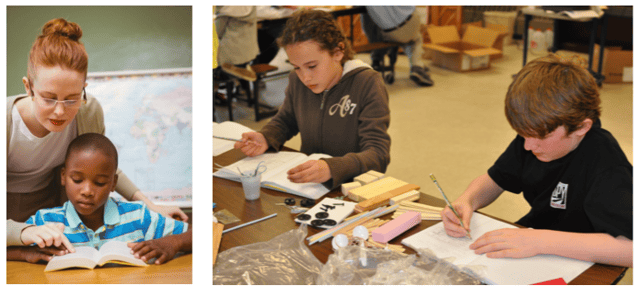One of the key pieces that we need to consider is the new definition of effective STEM instruction.
The National Research Council (NRC) developed the definition back in 2011 and today it is very clearly reflected in the new Next Generation Science Standards. An ongoing trickle-down effect from the NRC’s thinking accounts for the multi-state collaboration we have today: the Next Generation Science Standards. Now, if we want to stay on the same page, we must all share a common definition of what it means to teach STEM concepts effectively.
The NRC’s 2011 publication, “Successful K-12 STEM Education: Identifying Effective Approaches in Science, Technology, Engineering, and Mathematics,” contains the following definition:
Effective STEM instruction capitalizes on students’ early interest and experiences, identifies and builds on what they know, engages them in STEM practices, and provides them with experiences to sustain their interest.
Key elements that contribute to effective STEM instruction include:
- A coherent set of standards and curriculum
- Teachers with high capacity
- A supportive system of assessment and accountability
- Adequate instructional time, and
- Equal access to quality STEM learning opportunities
Moreover, schools – even those that rank high for poverty and hardship – share a number of other characteristics:
- Professional capacity among teachers
- Strong ties to parents and the community
- A student-centered learning climate, and Instructional guidance for teachers
As you can see from this definition and the attendant characteristics of schools with successful STEM programs, there really isn’t much room for the traditional model of teacher-as-sage, handing down wisdom from on high.
Moreover, STEM instruction is best started when students are young, as it “capitalizes on students’ early interest and experiences,” and continues year after year in districts with good programs.
It’s plain to see that “effective STEM instruction” isn’t something that only happens in a test year.
It's not something that only happens in middle school. It's something that starts early – in preschool, kindergarten and first grade – and is an intentionally nurturing process all the way through grade twelve. It identifies and builds on what students know at every step of the way.
This nurturing process trends vertically from pre-K to twelfth grade, but also throughout the school year from September through June. This intentional scaffolding of concepts provides students with experiences to engage in the practices, by which we mean the skills necessary to engage in STEM subjects. Therefore, if students are observing a demonstration, they are not engaging in the practices.
Authentic Inquiry Means Using Practices and Engaging with Content
Effective STEM instruction capitalizes on students’ early interest and background, identifies and builds on what they know, and provides them with experiences to engage them in the practices of science and sustain their interest.
The students on the left in the image above are not engaging in the practices; rather, they are watching a teacher modeling skills, and will go off to repeat them on their own. The students on the right are engaging in practices, however. In this picture, they are actually engaged as scientists and engineers. They're not mirroring anything back or attempting to repeat what was told to them, but are actively experiencing the material on their own and drawing relationships between various concepts and ideas.
This is a crucially important distinction.
This type of inquiry-based learning also requires that we put in place a sequence of curriculum that sustains student interest over time. We must move away from the old model in which we teach three units a year, where rocks and minerals, for instance, are a topic we teach for months on end without linking them to other types of content, subjects and crosscutting concepts.
We’re not saying you can’t focus on these topics, just that we must recognize how much dynamic content exists outside of rocks and minerals that we must link to and address as well. That will require rethinking how we provide these experiences, how we position students as scientists and engineers in the classroom in this next generation inquiry environment, and how we sustain student interest.
This last part is especially key as students start to transition out of the early grade levels where we are naturally more attuned with student interest, and transition to the middle school level where we tend to focus more and more on explaining content.
When we lose this interaction and begin unpacking content without offering students a turn in the driver’s seat, that’s when we begin to lose them.
So what are the goals of successful STEM instruction? According to the NRC report, the primary goals are to:
- Expand the number of students who ultimately pursue advanced degrees and careers in STEM fields and broaden the participation of women and minorities in those fields.
- Expand the STEM-capable workforce and broaden the participation of women and minorities in that workforce.
- Increase STEM literacy for all students, including those who do not pursue STEM-related careers or additional study in the STEM disciplines.
And effective STEM instruction, according to this report, may be measured in multiple ways, including:
- Student outcomes, as measured by more than success on standardized tests
- The number of schools that successfully organize around STEM principles, raising the bar for STEM education across the nation, setting an example for non-STEM-oriented schools to follow, and
- STEM instruction and practices within schools
As time goes on, we will see how well the above goals are achieved and begin to take the pulse of STEM’s entrance into our educational system by using the markers just discussed. For now, it’s enough to understand what effective STEM instruction is.
Put simply, it is effective teaching that enables the success of our nation’s next generation of scientists, engineers, salespeople, marketers and other professionals who will rely on higher-order thinking skills they learn through science, technology, engineering, and math.






